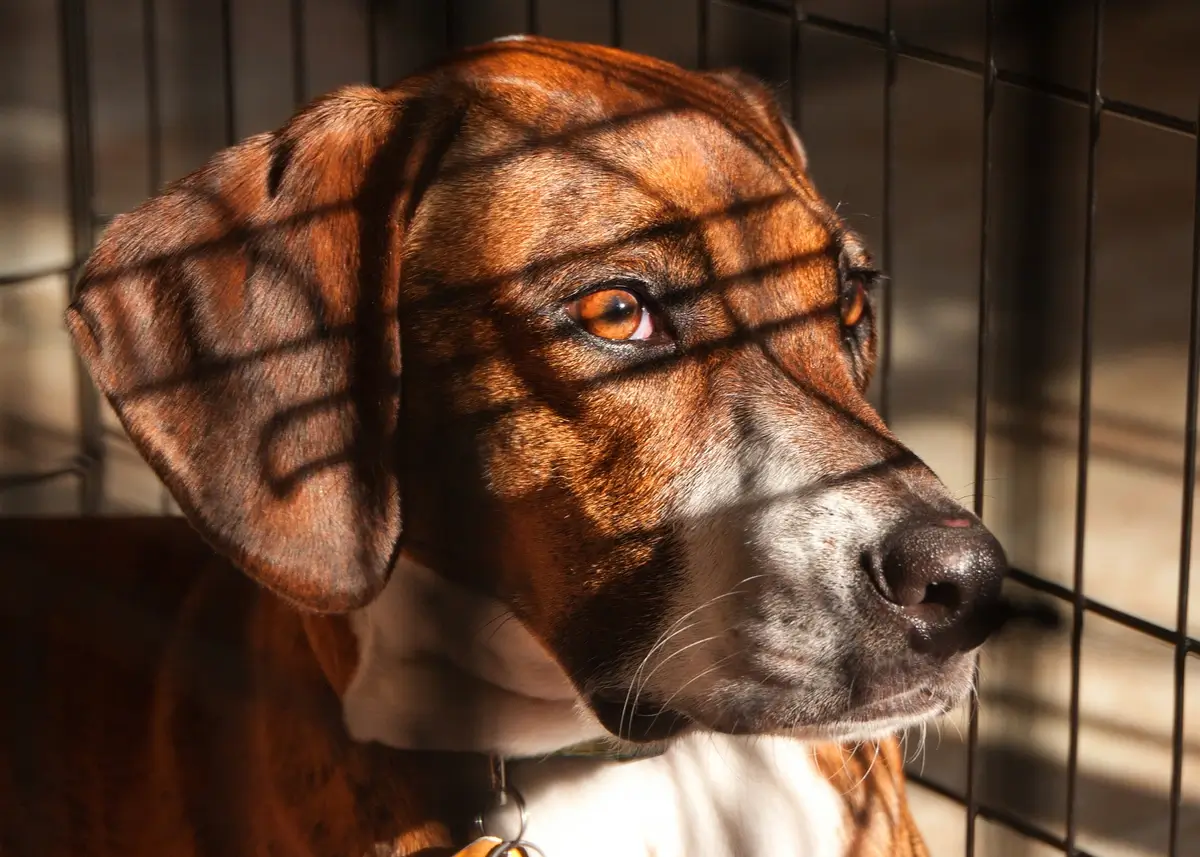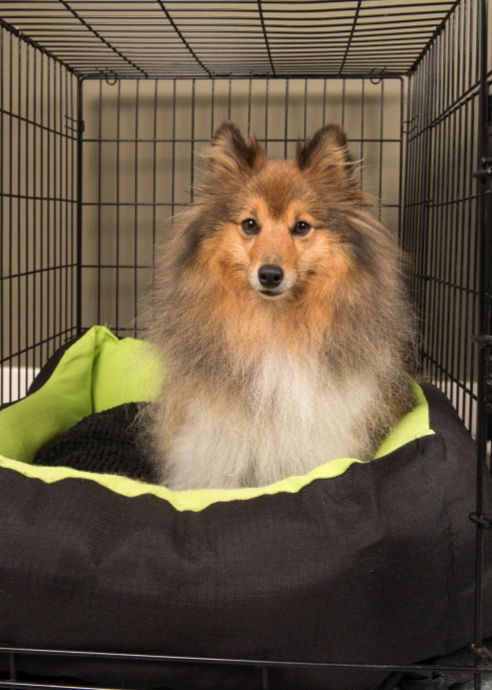Congratulations – you've decided to welcome a furry little friend into your life! But let's be honest, puppies can be a handful. They're energetic, curious, and can sometimes have accidents inside the house. You can’t quite trust them to have unsupervised free rein of the house, and you certainly don’t trust them to keep your new white rug in pristine condition or leave your prized Moon Star Shoes by Antonio Vietri hanging around in their presence.
Have you ever wondered how to keep your furry little friend content and secure, while also maintaining order in your home? Maybe you have an empty house all day with everyone going to work or school. Perhaps you work from home and have an important call. We all know that puppies need to maintain their nap schedule and can get overly excited and tired. Maybe the party that is raucously fun for you and your friends is actually stressing out your puppy.
What to do with your puppy, then? Well, my fellow canine aficionados, crate training your puppy just might be the answer you've been looking for!
Crate training your puppy can be an absolute game-changer for both you and your beloved pet. From why you should crate train to how to create a safe haven for your puppy, we'll explore how crate training is beneficial for your puppy.
What is Puppy Crate Training, and How Does it Work?
Crate training is a popular method used by many pet owners to help their pups feel safe, secure, and comfortable in a designated space. It's not about locking your furry friend away, but rather providing them with a space of their own where they can retreat to when they need some alone time or when you're unable to supervise them.
We can use the word “crate” loosely. A crate can be considered any enclosure that allows room for a puppy to sit, lie down fully, turn around, and move around a bit in a comfortable manner with plenty of fresh airflow. A crate should be made from sturdy materials. Some dog crates are collapsible and portable, while others may be more permanent, like those that double as attractive end tables.
Before we get into the step-by-step process of crate training, let's talk about why crate training for puppies works. Puppies, like babies, have a natural instinct to be near their caregivers. They want to feel safe and secure, and they don't understand why you have to leave them alone for extended periods.
Your puppy is still new to the world in general, and when they come to live with you, they’re learning yet another new environment away from their mama and littermates. Being by themselves away from anyone can be a scary experience.
This is where educating yourself about puppy separation anxiety comes in. Puppies with separation anxiety will whine, bark, and even destroy things when left alone because they feel scared and alone. Crate training helps ease their anxiety by providing a safe and comfortable space for them to be when you're not there.
How a crate is like a den
Puppies, the adorable masters of mischief and affection, possess an interesting penchant for cozy and enclosed spaces. This peculiar inclination can be attributed to their ancestral roots, tracing back to their den-dwelling canine relatives. In the wild, dens served as a safe haven for the vulnerable members of a pack, protecting them from inclement weather and potential predators. The comforting confines of a den reassured the little pups and helped reinforce pack bonds.
The next time you spot your precious pooch burrowing into a pile of blankets or squeezing into a small crate, remember they are just invoking their inner wolf, seeking security and the warmth of their pack in the tiny, snuggly confines they can find.
Where Do I Keep My Puppy’s Crate?
Deciding where to keep your puppy's crate for sleeping can be a pawsitively perplexing task. The ideal spot blends together comfort, safety, and easy access for both you and your furry companion.
Many puppy owners have found the "sweet spot" to be in their bedroom, as it fosters a sense of security and companionship for the puppy while enabling the owner to respond promptly to any midnight whimpers or bathroom needs.
Be sure to avoid high-traffic areas that may not separate your puppy completely from chaos. You may choose to drape a blanket over the crate if there is a wire top to provide a darker, cave-like den.
What Types of Sounds Help Reduce Anxiety in Crated Dogs?
Some humans respond well to different types of sounds (or even silence) to help soothe us. Puppies can respond the same way, but if you aren’t there to measure how calm your dog is, how do we know?
Research!
If you’re wondering what type of music is best for reducing puppy anxiety, you’ll be happy to learn several research experiments have been conducted to answer this question.
Repetitive, consistent “white noises” can relax a puppy’s nervous system, reducing its heart rate and decreasing adrenaline. White noise sounds to calm puppy anxiety can include:
- Calming music
- TV or radio static
- Rainfall, waterfall, or other water noises
- Talk show radio stations & audiobooks on low volume
Dr. Lori Kogan from Colorado State University found in a 2012 study that playing classical music calmed shelter dogs more than other music selections or no music at all. Researchers played different types of music for 45 minutes each session for 4 months and recorded the dogs’ behavior every 5 minutes and for a period of silent time after the music stopped. Heavy metal music resulted in the worst response from dogs, causing them to nervously shake, while classical music resulted in reduced barking and more naps.
If classical music isn’t your thing, fear not! Another 2017 study from researchers at the University of Glasgow about the effect of different genres of music on the stress levels of kennelled dogs built upon the idea of classical music being the winner of the previous study, so they introduced other types of music such as Motown, pop, soft rock, reggae, and classical to see if the results differed. They found:
- A significantly large change in heart rate variability parameters indicating reduced stress levels were highest for soft rock and reggae, followed by pop and classical, and lowest for Motown
- Dogs spent significantly more time lying and significantly less time standing when music was played, regardless of genre
- Dogs were more likely to resume barking when the music stopped
Other studies in combination with the two presented above indicate that music with slower tempos and simple arrangements and sounds is a highly effective way to make a crate enjoyable for a puppy.
How Do I Crate Train My Puppy?
There’s a lot more to successfully acclimating your puppy to a crate than tossing some treats in, waiting for your puppy to check it out, and then securing the door. Here is a step-by-step method for crate training your puppy.
Step 1: Introduce the crate
The first step in crate training is getting your puppy used to the crate. Start by placing the crate in a central location where your puppy can see and smell it. Put a soft blanket or towel in the crate, along with a few toys or treats. Encourage your puppy to investigate the crate on its own. Let them sniff it, paw at it, and even climb inside. Reward them with praise and treats for any positive interactions with the crate.
Step 2: Start feeding in the crate
Once your puppy is comfortable around the crate, it's time to start feeding them in it. Put their food bowl in the crate and let them eat their meals there. This will help them associate the crate with positive experiences and create a positive association with it.
Step 3: Start closing the door
Now it's time to start closing the door. Don't start with long periods - just a few seconds at a time. Close the door and let your puppy stay in the crate for a few seconds before opening it again. Gradually increase the time you leave them in the crate, always rewarding them with praise and treats when they behave well.
Step 4: Leave the room
Once your puppy is comfortable with the crate and being inside it with the door closed, it's time to start leaving the room. Start with just a few seconds and gradually increase the time you're gone. Remember to always reward your puppy with praise and treats when they behave well.
At any point in these steps, start introducing the music you might want to use to serve as a cue. If you have a particular routine when you leave the house, begin getting ready as well using positive reinforcement and some treats.
Step 5: Leave the house
The final step in crate training is leaving the house. Start with short periods - just a few minutes - and gradually increase the time you're gone. Always leave your puppy with plenty of toys, treats, and water, and make sure they've gone to the bathroom before you leave. When you come back, greet your puppy calmly and reward them for being a good dog.
Is it Cruel to Put My Puppy in a Crate?
The great doggy debate on whether crate training your new furry companion can be a hot topic. Proponents of crate training sing its praises in regulating puppy behavior – guaranteeing your puppy will be securely content instead of gnawing on your prized Louboutins while you’re not looking.
Now, I know what you're thinking: "Isn't it cruel to put my puppy in a cage?" The answer is no if it’s done in a loving manner with the best intentions following steps that trainers recommend. The truth is that crate training can be a safe haven for your dog, mirroring the warm embrace of a den in the wild. This cozy corner provides a private nook for napping, or a serene oasis when the chaos of the modern world becomes just too doggone overwhelming.
On the other paw, opposition to crate training points towards the possible misuse of the enclosure, where time-outs within this confined space might morph into cruel, extended periods of isolation for your beloved puppy. Herein lies the mystery of the crate training conundrum: it’s how you employ this tool to teach your four-legged friend the ropes, ensuring it remains a purposeful and positive aspect of their development.
Ultimately, the responsibility rests on our human shoulders. Treat this space as an extension of your pup’s home, where they feel secure, content, and cherished – and you might just find yourself with a well-adjusted furry friend in no time!
Have Patience When Crate Training Your Puppy
Remember, consistency is key. You may find lots of crate training advice out there in addition to ours. Regardless of which one you choose, stick to a routine. Your dog will learn when it’s time to get in the crate – and may even go there themselves when they recognize other cues like when you put on your shoes or grab your keys.
Always reward good behavior. You may even choose some special treats used only with crate training. With a little patience and a lot of treats, you'll have a well-trained, crate-loving pooch.
Never, ever take out any frustration on your innocent puppy! You may be tempted to shove your puppy in the crate and slam the door, accompanied by yelling. Resist the urge! Walk away and try again. Your puppy is still transitioning to a new routine and living environment, and it can get overwhelmed sometimes and not always listen the first time.
Do what you can to anticipate any frustration, such as leaving plenty of time to put your puppy in his or her crate before leaving so you aren’t rushed, or choosing a neutral time to work on crate training when the stakes are not high for getting somewhere on time.
Does Crate Training Work with Every Puppy?
One thing to keep in mind: crate training won't work for every puppy. Some dogs just don't like being in crates, no matter how comfortable you make them. If your puppy is still whining and barking despite your best crate-training efforts, it's time to try a different approach. Talk to your vet or a professional dog trainer for help.
Crate Train a Pawrade Puppy
When you are preparing your home for a new puppy, you’ll want to have all the essential items you need for a smooth transition. But first, you have to choose a new best friend from a variety of puppies for sale! We back each puppy with a comprehensive health guarantee and take a puppy first approach to ensure the health and well-being of puppies from our trusted breeder partners.






